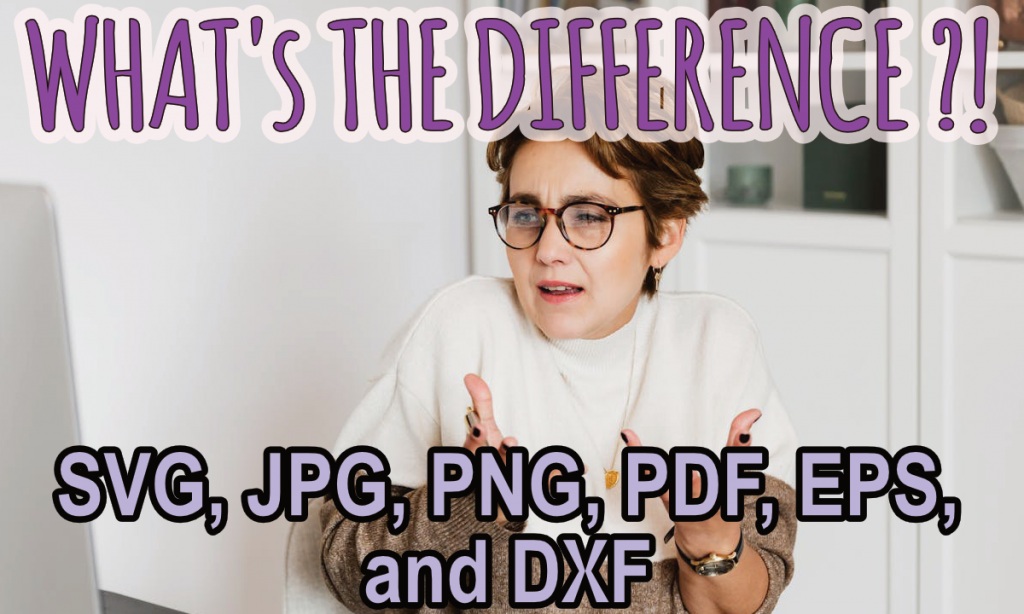If you’re trying to figure out the best file types for your crafting project, then you’ve come to the right place.
When it comes to creating, sharing, or printing graphics, choosing the correct file format is crucial. Each file type serves a unique purpose, whether for web design, print materials, or CAD applications. In this blog post, we’ll compare .SVG, .JPG, .PNG, .PDF, .EPS, and .DXF formats to help you better understand their differences, strengths, and best-use cases.
Quick Comparison Table
| File Type | Type | Transparency | Compression | Scalability | Best Use |
|---|---|---|---|---|---|
| SVG | Vector | Yes | Lossless | Infinite | Web graphics, scalable logos |
| JPG | Raster | No | Lossy | Limited | Photographs, web images |
| PNG | Raster | Yes | Lossless | Limited | Transparent images, web graphics |
| Vector/Raster | Sometimes | Lossless/Lossy | Infinite/Fixed | Print materials, documents | |
| EPS | Vector | No | Lossless | Infinite | High-res print graphics, logos |
| DXF | Vector | No | Lossless | Infinite | CAD, engineering designs |
1. SVG (Scalable Vector Graphics)
- Type: Vector
- Best Use: Web graphics, logos, and illustrations requiring scalability
- Key Features:
- SVG files use XML-based code to describe 2D graphics, which means they are infinitely scalable without losing quality.
- File size is typically small and efficient.
- Supports transparency and interactivity (like animation).
- Pros: Perfect for responsive web design.
- Cons: Limited browser compatibility for advanced features.
- Example Use: Website logos and illustrations.
2. JPG (Joint Photographic Experts Group)
- Type: Raster
- Best Use: Photographs and images with complex color gradients
- Key Features:
- JPG files are lossy-compressed, meaning some quality is sacrificed for a smaller file size.
- Ideal for sharing images online or embedding into emails.
- Does not support transparency.
- Pros: Compact file size makes it web-friendly.
- Cons: Repeated editing reduces quality.
- Example Use: Website images, social media photos.
3. PNG (Portable Network Graphics)
- Type: Raster
- Best Use: Web graphics needing transparency and sharper edges
- Key Features:
- PNG is a lossless file format, which preserves quality but results in larger file sizes.
- Supports transparency, making it excellent for web overlays and logos.
- Handles sharp edges and text well.
- Pros: Maintains quality; supports transparency.
- Cons: Larger file sizes compared to JPG.
- Example Use: Transparent web images, icons, screenshots.
4. PDF (Portable Document Format)
- Type: Vector & Raster (depending on content)
- Best Use: Print materials, multi-page documents, and sharing designs
- Key Features:
- PDF can handle both vector graphics and raster images.
- Widely used for document sharing and printing due to consistent formatting.
- Supports text, images, hyperlinks, and interactive forms.
- Pros: Preserves layout and works across devices.
- Cons: File size can increase with complex designs.
- Example Use: Brochures, e-books, presentation designs.
5. EPS (Encapsulated PostScript)
- Type: Vector
- Best Use: Professional print production, logos, and illustrations
- Key Features:
- EPS is primarily used for high-resolution vector graphics.
- Often employed for scalable logos and artwork for print.
- Compatible with design software like Adobe Illustrator.
- Pros: Maintains quality in large print formats.
- Cons: Limited support in web-based workflows.
- Example Use: Print graphics, logos for banners.
6. DXF (Drawing Exchange Format)
- Type: Vector
- Best Use: CAD designs and engineering drawings
- Key Features:
- DXF files are specifically designed for CAD (Computer-Aided Design) software.
- Often used to exchange 2D drawings between different design platforms.
- Excellent for precision designs and architectural plans.
- Pros: Cross-platform compatibility for CAD tools.
- Cons: Not suitable for web or print without conversion.
- Example Use: Engineering schematics, architectural blueprints.
Conclusion
Each file format serves a specific purpose:
- SVG for scalable, web-friendly graphics.
- JPG for photos with small file sizes.
- PNG for high-quality web images requiring transparency.
- PDF for print-ready designs and document sharing.
- EPS for professional-grade print graphics.
- DXF for precision CAD designs.
Choosing the right format can save you time, maintain quality, and ensure your project looks its best. For graphic design projects, consider your final use case to pick the perfect format.

